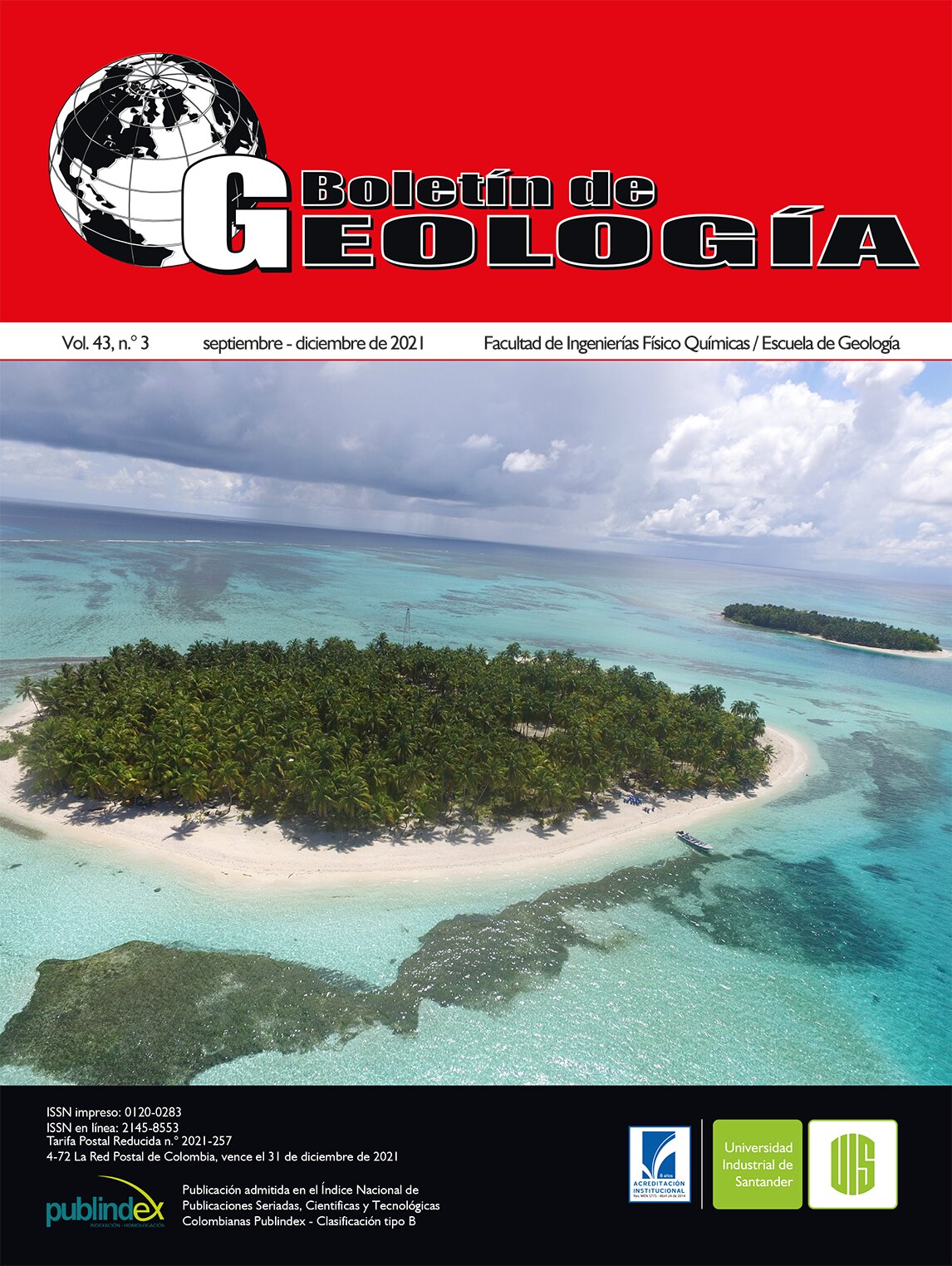Quantitative analysis of the fracture systems and groundwater implications in the south zone of the Mesa de Los Santos, Santander - Colombia
Published 2021-09-30
Keywords
- Statistical analysis,
- Fracture patterns,
- FracPaQ,
- Circular windows,
- Fluid flow
How to Cite
Copyright (c) 2021 Boletín de Geología

This work is licensed under a Creative Commons Attribution 4.0 International License.
Altmetrics
Abstract
The quantitative analysis of the fracture system is the use of statistical methods and procedures to determine the structures geometry and the parameters that describe the fracturing such as intensity, density, and fracture length with the purpose of identifying the most favorable areas for infiltration and fluid storage in a specific area. To implement this analysis in the south of the Mesa de Los Santos, the FracPaQ software was used, which measures and quantifies fracture patterns in two dimensions based on digital data obtain from outcrops photograph. This data is shown in range and dispersion maps to correlate with geologic attributes taken from each station. As additional information, a preliminary analysis of the flow of fluids is presented in graphs of connectivity and permeability in the direction of the flow. This quantification allowed establishing that the NW-SE faults stand out in the spatial arrangement and opening of the fractures, acting as the main corridors for the circulation of fluids in the southeast of the Mesa de Los Santos. We propose the zone influenced by the La Mojarra Fault as a sector of high secondary porosity favorable for infiltration and subsurface flow associated with the upper member of the Los Santos Formation.
Downloads
References
Clavijo, J.; Royero, J.M. (2001). Mapa geológico generalizado departamento de Santander. Escala 1:300.000. Memoria explicativa. Instituto Nacional de Investigaciones Geológico Mineras (INGEOMINAS).
Contreras, N. (2008). Análisis del fracturamiento presente en la Formación Los Santos al noreste y centro de la Mesa de Los Santos, departamento de Santander. Tesis de pregrado. Universidad Industrial de Santander, Bucaramanga, Colombia.
Díaz, E.; Contreras, N.M.; Pinto, J.E.; Velandia, F.; Morales, C.J.; Hincapie, G. (2009). Evaluación hidrogeológica preliminar de las unidades geológicas de la Mesa de los Santos, Santander. Boletín de Geología, 31(1), 61-70.
Healy, D.; Rizzo, R.E.; Cornwell, D.G.; Farrell, N.J.C.; Watkins, H.; Timms, N.E.; Gomez-Rivas, E.; Smith, M. (2017). FracPaQ: A MATLAB™ toolbox for the quantification of fracture patterns. Journal of Structural Geology, 95, 1-16. https://doi.org/10.1016/j.jsg.2016.12.003
Healy, D.; Rizzo, R. (2019). FracPaQ: Fracture pattern quantification. User guide version 2.6. https://github.com/DaveHealy-github/FracPaQ
Hincapié, G.; Veloza, J. (2009). Informe hidrogeológico de la Mesa de Los Santos. Bogotá. Instituto Colombiano de Geología y Minería (INGEOMINAS).
Julivert, M. (1958). La morfoestructura de la zona de las mesas al SW de Bucaramanga (Colombia S. A.). Boletín de Geología, 1, 7-43.
Manzocchi, T. (2002). The connectivity of two-dimensional networks of spatially correlated fractures. Water Resources Research, 38(9), 1-20. https://doi.org/10.1029/2000WR000180
Mauldon, M.; Dunne, W.M.; Rohrbaugh, M.B. (2001). Circular scanlines and circular windows: New tools for characterizing the geometry of fracture traces. Journal of Structural Geology, 23(2-3), 247-258. https://doi.org/10.1016/S0191-8141(00)00094-8
Morales, C.J.; Forero, H.; Rojas, N.; Alvarado, S. (2010). Integración geológica e hidrogeológica del centro de Santander. Bogotá. Instituto Colombiano de Geología y Minería (INGEOMINAS).
Moreno-Sánchez, G.; García-Cabrejo, O. (2006). Caracterización cuantitativa de patrones de fracturamiento mediante ventanas circulares y análisis fractal. Geología Colombiana, 31, 73-90.
Moreno, M.L.; Silva, K. (2021). Identificación de ambientes geomorfológicos y elaboración de un mapa de favorabilidad para la percolación de la zona de la Mesa de Los Santos, Santander. Tesis de grado. Universidad Industrial de Santander, Bucaramanga, Colombia.
Ortega, O.J.; Marrett, R.A.; Laubach, S.E. (2006). A scale-independent approach to fracture intensity and average spacing measurement. AAPG Bulletin, 90(2), 193-208. https://doi.org/10.1306/08250505059
París, G.; Machette, M.N.; Dart, R.L.; Haller, K.M. (2000). Map and Database of Quaternary Faults in Colombia and its Offshore Regions. U.S. Geological Survey Open-File Report 00-018 (1:2.000.000 scale). https://doi.org/10.3133/ofr00284
Pinto, J.E.; Clavijo, J.; Gómez, S.; Gutiérrez, D.; Mora, J.P.; Rojas, N.; Adarme, I.; Aldana, S.; Contreras, N.; Díaz, E.; Melo, L.; Reátiga, G.; Rincón, M.; Vargas, C.; Morales, C.; Velandia, F.; Hincapié, G.; Forero, H.; Duarte, R.; De Bermúdez, O. (2007). Proyecto de investigación geológica e hidrogeológica en la Mesa de Los Santos, sector noreste de Curití y borde occidental del macizo de Santander, departamento de Santander. Bucaramanga. Instituto Colombiano de Geología y Minería (INGEOMINAS).
Siravo, G.; Fellin, M.G.; Faccena, C.; Maden, C. (2020). Transpression and build-up of the cordillera: the example of the Bucaramanga fault (eastern cordillera, Colombia). Journal of the Geological Society, 177(1), 14-30. https://doi.org/10.1144/jgs2019-054
Taboada, A.; Rivera, L.; Fuenzalida, A.; Cisternas, A.; Philip, H.; Bijwaard, H.; Olaya, J.; Rivera, C. (2000). Geodynamics of the northern Andes: Subductions and Intracontinental deformation (Colombia). Tectonics, 19(5), 787-813. https://doi.org/10.1029/2000TC900004
Tarazona, Y.; Vargas, M.C. (2020). Análisis cuantitativo de sistemas de fracturas como aporte al conocimiento hidrogeológico de la zona sur de la Mesa de Los Santos, Santander - Colombia. Tesis de pregrado. Universidad Industrial de Santander, Bucaramanga, Colombia.
Vargas, C.Y. (2008). Cartografía geológica a escala 1:25.000 de la Mesa de Los Santos, departamento de Santander. Tesis de pregrado. Universidad Industrial de Santander, Bucaramanga, Colombia.
Velandia, F.; Silva, G.; Morales, C.; Osorio, J. (2007). Análisis cinemático de la región central del departamento de Santander. Memorias. XI Congreso Colombiano de Geología, Bucaramanga, Colombia.
Velandia, F.A. (2010). Análisis de fracturas para exploración de aguas subterráneas en el centro de Santander. En: Hidrogeología para la gestión del recurso hídrico (pp. 149-158). Universidad de Antioquia.
Velandia, F.; Bermúdez, M. (2018). The transpressive southern termination of the Bucaramanga fault (Colombia): insights from geological mapping, stress tensors, and fractal analysis. Journal of Structural Geology, 115, 190-207. https://doi.org/10.1016/j.jsg.2018.07.020
Velandia, F.; García-Delgado, H.; Zuluaga, C.A.; López, J.A.; Bermúdez, M.A.; Audemard, F.A. (2020). Present-day structural frame of the Santander Massif and Pamplona Wedge: The interaction of the Northern Andes. Journal of Structural Geology, 137. https://doi.org/10.1016/j.jsg.2020.104087
Yong Technology Inc. (2015). GeoRose 0.5.1. A free geological Rose diagram and stereonet plotting program. Edmonton, Canada. http://www.yongtechnology.com/georose/

